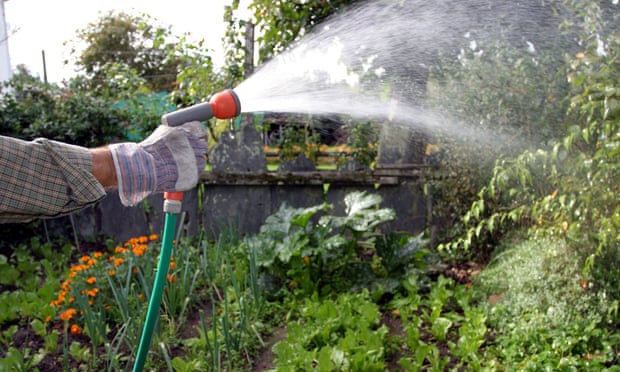water-saving tips for a sustainable garden


Understanding the Importance of Water Conservation
The Need to Conserve Water in Your Garden
As a gardener concerned about the environment, you may be wondering how you can make your garden more sustainable. One crucial aspect of creating an eco-friendly garden is water conservation.
Conserving water in your garden is important for several reasons. First and foremost, it helps to preserve one of our planet's most valuable resources. Water scarcity is a pressing global issue, and every drop counts. By reducing water usage in your garden, you play a role in mitigating this problem.
Additionally, conserving water can lower your utility bills. Watering your plants efficiently and applying proper irrigation techniques can significantly reduce water wastage, resulting in cost savings over time.
Benefits of a Sustainable Garden
Creating a sustainable garden has numerous benefits beyond water conservation. It promotes biodiversity by attracting beneficial insects, birds, and other wildlife. These creatures play a vital role in pollination and pest control, helping to maintain a healthy ecosystem in your garden.
A sustainable garden also enhances the visual appeal of your property. Using native plants and implementing eco-friendly landscaping techniques can create a beautiful and vibrant garden that requires less maintenance and resources.
Furthermore, a sustainable garden reduces the need for chemical pesticides and fertilizers, creating a healthier environment for both flora and fauna while minimizing the risk of soil and water pollution.
Overall, implementing water-saving practices and creating a sustainable garden is a responsible and environmentally conscious choice that benefits not only you but the planet as a whole. By conserving water and embracing eco-friendly gardening methods, you can contribute to a greener and more sustainable future.

Planning Your Sustainable Garden
When it comes to creating a sustainable garden, water conservation should be a top priority. By implementing these water-saving tips, you can reduce your water usage while still enjoying a beautiful and thriving garden.
Assessing Your Garden's Water Needs
Determine Water Requirements: Start by evaluating the specific needs of your plants. Different plants require different amounts of water, so it's crucial to group them accordingly. Consider factors such as soil type, sun exposure, and climate to ensure you provide the right amount of water without waste.
Consider Irrigation Methods: Efficient irrigation systems, such as drip irrigation or soaker hoses, can significantly reduce water usage. These methods deliver water directly to the roots, minimizing evaporation and runoff. In contrast, sprinklers often lead to water loss due to wind and evaporation.
Choosing Drought-Tolerant Plants
Select Water-Smart Plants: Opt for native or drought-tolerant plant species that have adapted to local conditions. These plants require less water and can thrive even during dry periods. Research your region's native plant species or consult with a local nursery to identify suitable options.
Group Plants Strategically: Arrange plants with similar water needs together to optimize watering efficiency. This way, you can target specific areas that require more water while limiting water usage in areas with drought-tolerant plants.
Remember, proper planning and thoughtful plant selection are key to creating a beautiful and sustainable garden that minimizes water waste. By conserving water and choosing the right plants, you can enjoy a flourishing garden while preserving this precious resource for future generations.

Efficient Irrigation Techniques
When it comes to maintaining a sustainable garden, water conservation is key. By implementing efficient irrigation techniques, you can minimize water waste and ensure that your garden thrives while still being environmentally friendly. Here are some tips to help you save water in your garden.
Drip Irrigation Systems and their Benefits
Consider installing a drip irrigation system in your garden. Unlike traditional sprinkler systems, drip irrigation delivers water directly to the base of your plants, minimizing evaporation and runoff. This targeted approach ensures that water is delivered exactly where it is needed, reducing water waste.
Additional benefits of drip irrigation include:
-
Conserves water: Drip irrigation can save up to 50% more water compared to traditional sprinkler systems.
-
Prevents weed growth: Since water is delivered directly to the plants, the surrounding soil remains dry, reducing weed growth.
-
Prevents disease: Drip irrigation avoids wetting the leaves of the plants, which can reduce the risk of fungal diseases.
Watering with Rainwater Harvesting
Another effective way to save water in your garden is by implementing rainwater harvesting. Collecting rainwater allows you to utilize natural water sources instead of relying solely on freshwater. You can install rain barrels, tanks, or even create a rain garden to collect and store rainwater for future irrigation needs.
Benefits of rainwater harvesting include:
-
Reduces water bills: Using rainwater for irrigation purposes can significantly reduce your water bills.
-
Sustainable water source: Rainwater is a natural and sustainable source of water, reducing the strain on freshwater resources.
-
Improves plant health: Rainwater is free from chemicals such as chlorine, making it better for your plants' overall health and growth.
By implementing these efficient irrigation techniques and water-saving practices, you can create a sustainable garden that conserves water without compromising the health and beauty of your plants.

Soil Management for Water Conservation
Improving Soil Structure and Water Retention
To create a sustainable garden that conserves water, it is essential to focus on soil management. By improving the structure and water retention of your soil, you can reduce the amount of water needed for your plants to thrive.
Soil structure plays a crucial role in water conservation. Compacted soil can prevent water from penetrating deep into the ground, leading to runoff and wasted water. To improve soil structure, you can incorporate organic matter such as compost or well-rotted manure. This will help loosen the soil, allowing water to infiltrate more effectively and reducing the need for frequent watering.
Furthermore, adding organic matter to your soil enhances its water retention capacity. Organic matter acts like a sponge, holding onto moisture and releasing it slowly over time. This helps to keep your plants hydrated without excessive water usage. You can apply a layer of compost or mulch around your plants to preserve moisture and prevent evaporation.
Mulching to Reduce Evaporation
Mulching is another effective technique for water conservation in a sustainable garden. By applying a layer of organic mulch, such as wood chips, straw, or shredded leaves, you can greatly reduce evaporation and water loss.
Mulch acts as a protective barrier, shielding the soil from direct sunlight and wind. This helps to keep the soil cool and moist, preventing water from evaporating too quickly. Mulch also suppresses weed growth, reducing competition for water resources.
Remember to periodically check the moisture level of your soil and adjust watering accordingly. Overwatering can be wasteful and harmful to plants, so it is important to find the right balance.
By implementing these soil management techniques and incorporating water-saving practices, you can create a sustainable garden that conserves water without compromising the health and beauty of your plants.

Sustainable Practices in Garden Maintenance
Proper Timing and Frequency of Watering
When it comes to maintaining a sustainable garden, understanding the proper timing and frequency of watering is essential. Here are some tips to help you water your garden wisely:
-
Water Early in the Morning: Watering your plants early in the morning allows the soil to absorb the moisture before the heat of the day causes evaporation. This ensures that the water reaches the roots effectively.
-
Avoid Overwatering: Overwatering not only wastes water but also harms the plants. Before watering, check the moisture level of the soil by inserting your finger about an inch deep. If it feels moist, there's no need to water yet. Only water when the soil is dry.
-
Use Drip Irrigation: Drip irrigation systems deliver water directly to the roots of the plants, minimizing wastage. These systems are efficient and reduce water loss through evaporation or runoff.
Practical Tips for Watering Wisely
To conserve water and maintain a sustainable garden, consider the following tips:
-
Apply Mulch: Mulching helps retain moisture in the soil by reducing evaporation. Apply a layer of organic mulch around your plants to keep the soil cool and moist.
-
Group Plants with Similar Watering Needs: By grouping plants with similar watering requirements together, you can avoid overwatering or underwatering certain plants.
-
Collect Rainwater: Installing rain barrels or collecting rainwater in containers can provide a sustainable source of water for your garden. Use this collected water during dry spells to reduce reliance on tap water.
By implementing these water-saving tips, you can maintain a sustainable garden while conserving water resources. Remember, sustainable practices in garden maintenance play a vital role in preserving our environment and ensuring the long-term health of your garden.

Creative Water-Saving Features for Your Garden
If you're aiming to create a sustainable garden, conserving water is essential. By incorporating water-saving features, you not only save water but also reduce your environmental impact. Here are some practical tips to help you achieve a water-efficient garden.
Installing Rain Barrels or Cisterns
One effective way to conserve water is by installing rain barrels or cisterns. These containers collect and store rainwater from your roof, which can then be used for watering your plants. By utilizing this natural resource, you can reduce your reliance on tap water and lower your water bill.
Creating a Water-Friendly Landscape Design
Designing your garden with water conservation in mind is another smart approach. Consider the following techniques:
-
Incorporate native plants: Choose plants that are well-suited to your climate and soil conditions. Native plants are typically more drought-resistant and require less water.
-
Group plants with similar water needs: Arrange your plants according to their water requirements. This allows for more efficient watering and prevents overwatering or underwatering.
-
Use mulch: Apply a layer of organic mulch around your plants. Mulch helps retain moisture in the soil, reducing the need for frequent watering.
-
Install a drip irrigation system: Drip irrigation delivers water directly to the plant's roots, minimizing water loss through evaporation and runoff.
Implementing these creative water-saving features will not only help you conserve water but also contribute to a more sustainable and eco-friendly garden.

Conclusion
By implementing these water-saving tips in your garden, you can contribute to sustainability efforts and reduce water consumption. Not only will this benefit the environment, but it will also save you money on water bills. Remember to make adjustments based on your specific climate, soil type, and plant species to ensure optimal water usage.
Embracing Sustainable Water Practices in Your Garden
-
Choose Native Plants: Native plants are adapted to the local climate and require less water compared to non-native species. They also provide habitat for local wildlife.
-
Efficient Irrigation: Use drip irrigation or soaker hoses instead of sprinklers to deliver water directly to plant roots. Install a rain barrel to collect rainwater for watering your garden.
-
Mulching: Apply a layer of organic mulch around plants to reduce water evaporation, regulate soil temperature, and suppress weed growth.
-
Watering Schedule: Water your garden early in the morning or late in the evening when temperatures are cooler to minimize evaporation. Avoid overwatering by checking soil moisture levels before watering.
-
Reduce Lawn Areas: Lawns require more water than other plants. Consider replacing part of your lawn with drought-tolerant ground covers, native grasses, or low-water-use plants.
Further Resources for Water-Saving Ideas
For more information on sustainable water practices and water-saving ideas for your garden, consult the following resources:
- EPA WaterSense Outdoor Water Efficiency
- Irrigation Association Landscape Water Management
- Arbor Day Foundation Water Conservation Tips
Remember, small changes can make a big difference in conserving water and creating a sustainable garden. Start implementing these tips today to enjoy a beautiful garden while minimizing water usage.



